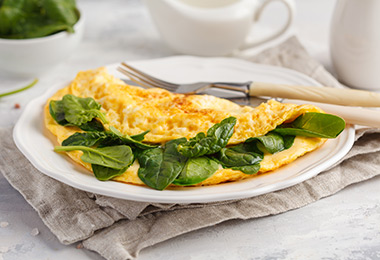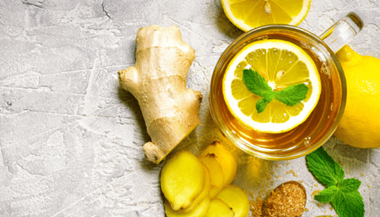Turmeric Benefits
Featured Expert
-
Mary-Eve Brown, R.D.N., C.S.O., L.D.N.

Turmeric is a deep, golden-orange spice known for adding color, flavor and nutrition to foods. A relative of ginger, turmeric comes from the rhizome (root) of a native Asian plant and has been used in cooking for hundreds of years. It has also been used in ayurvedic and other forms of traditional medicine in China and India.
Mary-Eve Brown, an oncology clinical dietitian/nutritionist at Johns Hopkins Medicine, provides information on health benefits of turmeric, how to use it in your cooking and two recipes that feature the spice.
What is turmeric good for?
Brown explains that the active ingredient in turmeric is a natural compound (polyphenol) called curcumin, which has both antioxidant and anti-inflammatory properties.
“Curcumin has many biological activities, not all of which are understood,” Brown says. “Like other colorful plant-based foods, turmeric is rich in phytonutrients that may protect the body by neutralizing free radicals (pollution, sunlight) and shielding the cells from damage.” Diets rich in plant-based foods are associated with prevention of medical conditions such as cancer and heart disease.
Brown says, “Anyone who’s trying to manage inflammation could benefit from adding some turmeric to their foods.” She cites inflammatory conditions such as arthritis and other joint disorders, colitis, allergies and infections.
Science Behind Turmeric
Turmeric and its components, including curcumin, have been the subject of scientific studies.
“Some research results show that people who have osteoarthritis reported less joint pain when eating turmeric in recipes,” Brown says. “Turmeric’s effect on mood disorders, depression and dementia have also been explored, but studies are small, so more research will reveal if there is a benefit.”
In addition to these conditions, research studies have shown some possible benefits of turmeric for:
- Inflammation
- Degenerative eye conditions
- Metabolic syndrome
- Arthritis
- Hyperlipidemia (cholesterol in the blood)
- Anxiety
- Muscle soreness after exercise
- Kidney health
Turmeric Supplements
Brown says turmeric supplements are probably not a good idea. As wonderful as turmeric’s nutritional benefits can be, more curcumin is not necessarily better, and too much can be risky.
For instance, turmeric supplements may increase your risk of kidney stones, especially if this runs in your family. Curcumin supplements contain much higher concentrations of the compound than a person would consume by eating food flavored with the spice or by drinking turmeric tea.
“One challenge of turmeric is that curcumin and other active ingredients are not bioavailable, meaning they are not easily absorbed by the body. Also, the digestive process breaks these beneficial compounds down and eliminates them quickly,” Brown says.
With that in mind, incorporating the spice regularly into your meals can safely boost your intake. Combining the spice with black pepper may help increase your body’s ability to absorb turmeric’s beneficial compounds. A substance in black pepper called piperine, when combined with curcumin, has been shown to increase bioavailability by 2000%.
“It’s better to get curcumin and most other nutrients in whole food form rather than to take turmeric pills, tinctures, capsules or gummies,” she says.
Turmeric Supplements and Drug Interactions
High doses of curcumin, as found in concentrated turmeric supplements, can interact with certain medications.
Pain relievers: Turmeric supplements can lessen the effects of indomethacin, aspirin, ibuprofen or acetaminophen.
Chemotherapy: If you are receiving chemotherapy treatments, talk to your doctor before taking turmeric supplements, and especially avoid them if you are taking these chemotherapy agents:
- Camptothecin
- Mechlorethamine
- Doxorubicin
- Cyclophosphamide
Blood thinners: Turmeric or curcumin supplements can increase the risk of bleeding in people taking warfarin.
Immunosuppressive drugs: People taking a medication called tacrolimus may experience increased side effects if they consume high amounts of curcumin.
Turmeric Side Effects
While turmeric is safe for most people when enjoyed in tea or food, if you are allergic to the spice, eating it may cause a rash, hives or abdominal pain.
Most of the side effects are associated with very high concentrations of curcumin found in supplements (pills, capsules and gummies).
How to Enjoy Turmeric
Turmeric is used as a natural coloring agent for some kinds of mustard, and it is an ingredient in curry powder. Brown says she enjoys the earthy flavor of turmeric on its own, and notes that it adds a depth of flavor and a pleasing color to Thai or other Asian dishes, as well as stews and chilis. “It’s great in chicken soup,” she notes.
Brown buys whole turmeric root in the produce section, and says she puts turmeric root pieces in freezer bags and freezes them to keep them fresh for up to six months.
She notes that the yellow pigment of turmeric can stain countertops and fabric, so you should be careful when working with it. Gentle abrasives or chlorine-based cleansers can remove the stains from many surfaces.
Turmeric Tea
Like ginger, turmeric root can be made into a nourishing and tasty tea. Here’s Brown’s method:
- 2 tablespoons turmeric root chopped or 2 teaspoons turmeric powder
- Bring to a boil in 1–2 cups water
- Lower to simmer for 5 minutes and then strain.
“You can drink turmeric tea warm or cold, and add lemon and/or honey to change the taste,” Brown advises.
Recipe: Curried Pumpkin Butternut Squash Creamy Vegan Soup
Ingredients
- Olive oil
- 1 pound each pumpkin and butternut squash, peeled and diced
- 2 shallots, diced
- 2–3 tablespoons Thai red curry paste
- 2 tablespoons grated turmeric root or 2 teaspoons turmeric powder
- 4 cups vegetable stock or broth
- 1 can unsweetened coconut milk (can use full fat or low fat)
- Salt and pepper
Directions
- Roast pumpkin and butternut squash with olive oil, salt and pepper at 400 degrees for 10 to 15 minutes. They are done when they are fork tender.
- In a large heavy stock pot or Dutch oven, sauté shallot, red curry paste and turmeric in olive oil for 8 to 10 minutes. The shallot should be soft and translucent.
- Add vegetable broth, roasted pumpkin and squash.
- Simmer for at least 20 minutes.
- Taste and adjust with salt, pepper or red curry paste.
- Add coconut milk and simmer.
- Blend either with stand blender or immersion blender.






